
PREV ARTICLE
NEXT ARTICLE
FULL ISSUE
PREV FULL ISSUE
MORE ON ENGRAVING STYLES
Mark Tomasko submitted these thoughts in response to Pete Smith's question about engraving styles. Thanks!
-Editor
I can provide some information relating to sources of lettering and what the practice was in the bank note industry. (By the way, Mike Bean is a former plate printer, not engraver, with the Bureau. And he is a great plate printer!) In the bank note world, lettering on bank notes, securities, and stamps was normally done by a designer, who (until the computer took over) would produce a model, in pencil or ink, of the lettering to be engraved. In larger firms, such as American Bank Note Company, there were square letter engravers and script engravers. In smaller firms, the letter engraver would do both types of lettering. Also, in smaller firms, sometimes the letter engraver would do the pencil model too. Two mid-nineteenth century sources for engraved alphabets were: (a) Becker's Ornamental Penmanship/A Series of Analytical and Finished Alphabets by George J. Becker, Philadelphia, Uriah Hunt, n.d. Most of the plates are engraved. (Besides the original mid-nineteenth century edition, there was a 1940s reprint from the original intaglio plates. I have both.) (b) A Series of Alphabets Designed as a Textbook for Engravers and Painters of Letters by Archibald McLees, Bank Note Engraver, New York. Ivison, Blakeman, Taylor & Co. N.Y. (Copyright date is 1855). Again, it is a book of engraved plates. While the mechanics and sources of letter engraving are not my specialty (picture engraving is what I know best), I would strongly suspect that masterplates were not used for security work at firms such as American Bank Note. I do know that in the era of artistic lettering (1880s-1890s) there were some very creative and interesting letterforms that were used on securities and bank notes that were the creation of bank note designers. For commercial (non-security) engraving—social stationery and the like— masterplates were common, at least in the twentieth century. See Robert Steffens: Engraved Stationery Handbook (New York: The Cronite Co., 1950), which has a series of engraved plates illustrating lettering from masterplates they offered for sale.
John Sallay submitted some thoughts as well. Thanks!
-Editor
Pete Smith’s query on engraving styles was of great interest to me because a large portion of my school medal collection consists of completely hand engraved pieces. And many more have hand engraved inscriptions on one or both sides of a struck medal or coin. While I have not studied this subject in the kind of detail that Pete and I both hope someone will attempt someday, here are some observations based on a few thousand items I have.
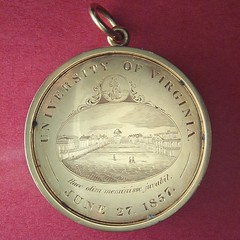
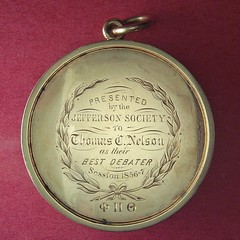
Only a small handful of engraved medals are signed by the engraver. An American example dated 1857 from the University of Virginia Jefferson Society is signed in script on the edge “Made by Canfield, Bro. & Co. Baltimore”. More on this medal and its humorous Latin inscription can be found at http://www.neocollect.com/coll/11/). A very similar and even more elaborate medal from the same society dated 1860 is not signed, though.
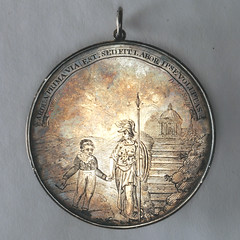

Another completely signed engraved medal is the Halloran Prize Medal, which was awarded during the 1820’s in Sydney Australia. Based on a similar unsigned medal that was also commissioned by schoolmaster Laurence Halloran in Exeter, England, it was engraved by Samuel Clayton (signed under the obverse banner “S. Clayton Delt. et Sculpt.”). Clayton, who was obviously a very skilled engraver, had been “transported” to Australia – which was then a penal colony – for banknote forgery. Halloran was there on his second trip, the first for impersonating a chaplain in the British Navy, and then for forgery on his second round. (For the complete story, see http://www.neocollect.com/coll/13/).
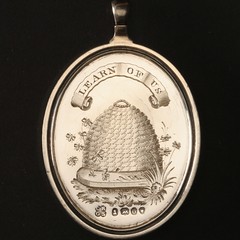
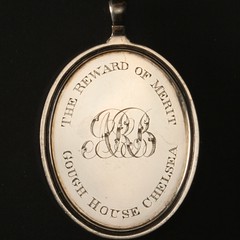
Several of the most elaborately engraved British medals from the Georgian and early Victorian periods are not signed per se but are hallmarked, as with this Gough House medal. You can often look up the silversmith in one of the many directories of silver hallmarks. Even when hallmarked, however, these medals may not have been engraved by the named master silversmith because the larger silversmith shops often had one or more journeymen and apprentices, and the engraving duties sometimes fell to these more junior people. I have only one hallmarked American engraved medal done in Connecticut in 1825 and do not know of any others.
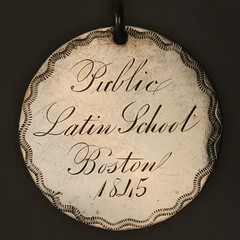

Engraved handwriting styles can often help identify a few medals as being from the same hand, but this similarity is not always definitive. For example, the long series of hand engraved Boston Latin School medals from the mid-1820’s to mid-1840’s seems to be from the same hand (see the bottom of page www.neocollect.com/coll/11/?page=4 for several examples), but there are slight nuances in the engraving style and some are clearly different. I’ve wondered if even the very similar examples may have been done by different engravers, since penmanship was a well drilled subject in grammar schools at that time. Unlike today’s emphasis on individuality, the teachers then emphasized conformity. But because of the relatively slower transportation and communication, regional stylistic differences arose and so you have, in this case, a medallic example of the “Boston Hand”. Finally, in addition to the handwriting style which can help identify a medal to a geography and/or time period, you also see distinctive decorative details engraved on medals, such as borders or leaves. This same Boston Latin School medal, for example, has what’s called a wrigglework border, which signals 18th or early 19th century Britain or northeast America. This is a whole subject itself, for another time.
To read the earlier E-Sylum article, see:
QUERY: STUDY OF ENGRAVING STYLES SOUGHT
(www.coinbooks.org/esylum_v17n19a14.html)
The Numismatic Bibliomania Society is a non-profit organization promoting numismatic literature. See our web site at coinbooks.org. To submit items for publication in The E-Sylum, write to the Editor at this address: whomren@gmail.com To subscribe go to: https://my.binhost.com/lists/listinfo/esylum All Rights Reserved. NBS Home Page Contact the NBS webmaster 
|